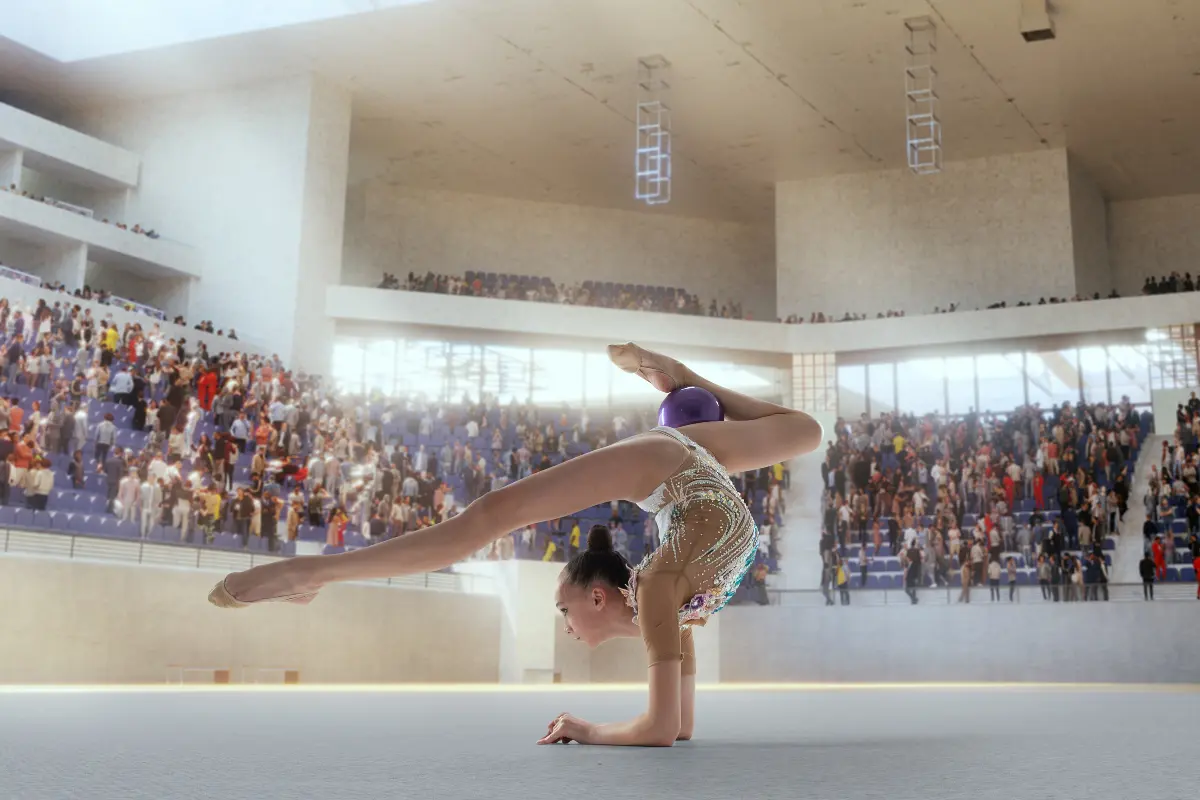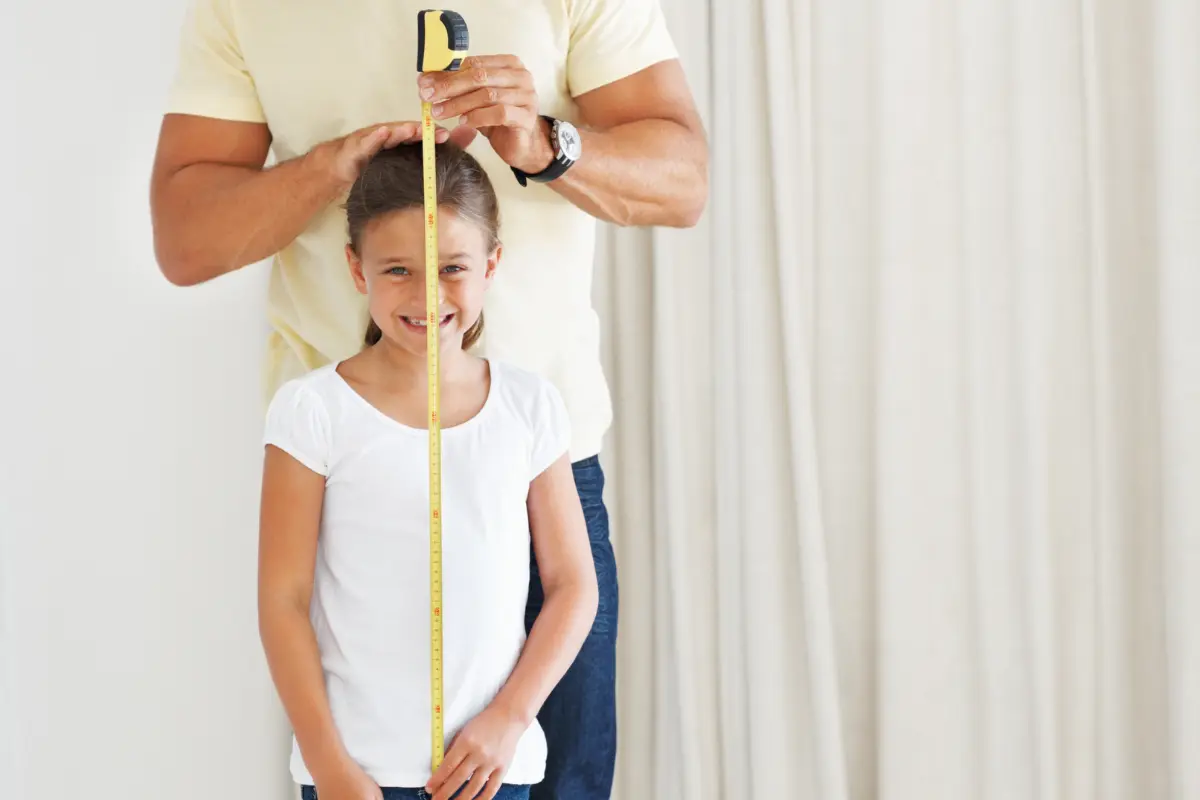From spring floors to high bars and spinning ribbons, gymnastics apparatus are as fascinating as the athletes who use them. In this beginner’s guide, we’ll cover what each apparatus is, how it’s used, and what makes it essential to the sport across all gymnastics disciplines.
Contents
Artistic Gymnastics Apparatus
Artistic gymnastics is the most recognized discipline in the sport, featuring powerful and graceful routines performed on various apparatus. Events are separated by gender, with women competing on four apparatus and men on six. Each one demands a unique mix of strength, balance, agility, and artistry.
Women’s Artistic Gymnastics (WAG)
| Apparatus | Key Measurements | Performance Focus |
|---|---|---|
| Vault Table | Vaulting surface: 120 × 95 cm; height: 1.25 m (women) / 1.35 m (men); runway: 25 m carpeted | Converts sprint speed into vertical lift, flips, and twists. |
| Uneven Bars | High bar: 2.50 m, Low bar: 1.70 m; bar spacing: 1.6–1.8 m adjustable | Swinging, transitions, and high-flying release moves with rhythm and regrasp. |
| Balance Beam | Width: 10 cm; Length: 5 m; Height: 1.25 m; surface: suede-covered with spring layer | Precision in acrobatics, leaps, and turns with no margin for error. |
| Floor Exercise | Floor area: 12 × 12 m sprung platform; border: 1 m safety zone | Powerful tumbling mixed with expressive dance (women) or strength skills (men). |
🔸 Vault Table
The vault is a high-speed event that begins with a 25-meter sprint down a runway. At the end, gymnasts punch off a springboard and launch themselves over a padded vault table—measuring 120 cm long by 95 cm wide and set at a height of 1.25 m for senior competitions.
During their flight, athletes perform dynamic flips and twists, then aim for a clean, controlled landing. Judges evaluate the vault based on height, body position, distance, execution, and precision of the landing.
🔸 Uneven Bars
One of the most technical events in women’s gymnastics, the uneven bars consist of two horizontal rails set at different heights—approximately 1.7 m (low bar) and 2.5 m (high bar), spaced 1.6–1.8 m apart. Gymnasts swing, release, and regrasp the bars while transitioning between them with fluid motion.
Routines often include pirouettes, flight elements, and transitions that require incredible timing and upper-body strength. Judges reward continuous momentum, tight body form, clean handstands, and difficulty.
🔸 Balance Beam
The balance beam is arguably the most nerve-wracking apparatus in gymnastics. Just 10 cm wide, 5 m long, and elevated 1.25 m off the ground, it demands complete control.
Gymnasts perform acrobatic series, leaps, turns, and choreographic elements in a connected routine. The suede-covered surface provides grip but also harshly penalizes any wobbles or hesitations. Judges evaluate artistry, confidence, fluidity, and error-free execution.
🔸 Floor Exercise
This is the most expressive and crowd-pleasing event in women’s gymnastics. Performed on a 12 × 12 m spring floor with a 1-meter safety border, the floor exercise combines athletic power with musical interpretation.
Gymnasts perform a 90-second routine that features tumbling passes, dance, leaps, and expressive movements choreographed to music. Judges assess the difficulty of the tumbling, the artistry of the routine, execution quality, and how well it matches the music.
Sources: FIG Apparatus Norms, Wikipedia, Spieth Gymnastics, American Gymnast and Ninja
Men’s Artistic Gymnastics (MAG)
| Apparatus | Key Measurements | Performance Focus |
|---|---|---|
| Pommel Horse | Body: 160 cm long, 35 cm wide; Height: 1.15 m; Pommel spacing: 40 cm | Continuous circular motions, scissors, and flairs that demand rhythm and endurance. |
| Still Rings | Ring diameter: 18 cm; Hang height: 3.00 m; Ring spacing: 50 cm | Transitions from swing to static holds (e.g., Iron Cross, Maltese) with precision. |
| Parallel Bars | Rail length: 3.50 m; Rail spacing: 42–52 cm; Height: 2.00 m | Combines swing elements, strength holds, and high dismounts at bar ends. |
| Horizontal Bar | Bar height: 2.78 m; Length between uprights: 2.40 m; Bar diameter: 2.8 cm | Fast giant swings, high-release skills, and twisting aerial dismounts. |
🔹 Floor Exercise
The men’s floor exercise takes place on the same 12 × 12 m sprung floor used in women’s gymnastics—but without music and with a stronger focus on strength, acrobatic difficulty, and control.
Routines last up to 70 seconds and include powerful tumbling passes, strength holds, flairs, and transitions. Judges assess amplitude, variety of skills, clean landings, and overall body control throughout the performance.
🔹 Pommel Horse
The pommel horse is one of the most rhythmically demanding apparatus in men’s gymnastics. It consists of a leather-covered body 160 cm long and 35 cm wide, with two handles (pommels) placed about 40 cm apart.
Using only their hands, gymnasts perform continuous circular motions—called circles—along with scissor swings, flairs, and traveling elements from one end of the horse to the other. Judges look for uninterrupted flow, even rhythm, and precision in form. Touching the horse with the legs or pausing breaks the rhythm and leads to deductions.
🔹 Still Rings
Suspended 3 meters above the floor, the still rings require extreme upper body strength, body control, and mental focus. The rings themselves are 18 cm in diameter and spaced 50 cm apart.
Routines combine swinging elements and static strength holds—such as the Iron Cross, Maltese, and planche—followed by a dynamic dismount. Judges evaluate the difficulty of strength positions, the ability to keep the rings stable, and the execution of both swing and strength transitions.
🔹 Vault
In the men’s vault, gymnasts sprint down a 25-meter runway, spring off a board, and launch over a vaulting table set at 1.35 m in height. While airborne, they execute difficult flipping and twisting skills before landing.
Men’s vaults often involve more complex body rotations than women’s. The vault is scored based on the difficulty value of the vault performed, the height and distance traveled, execution, and landing control.
🔹 Parallel Bars
The parallel bars are two wooden rails, each 3.5 m long and spaced 42–52 cm apart, elevated 2 m above the floor. Gymnasts perform a mix of swinging elements, strength holds, under-bar transitions, and high dismounts.
The event rewards seamless transitions, control in upper-arm support positions, and amplitude in swings. Judges also value clean handstands and precise landings.
🔹 Horizontal Bar (High Bar)
Also known as the high bar, this event features a single 2.8 cm-thick steel bar mounted 2.78 m above the floor. Gymnasts grip the bar and perform continuous giant swings, release-and-regrasp elements (such as Tkatchevs and Kovacs), and complex dismounts involving multiple twists and flips.
High bar routines are fast, fluid, and visually dramatic. Judges reward flight amplitude, form, and stuck landings, while any missed grip or form break results in major deductions.
Sources: FIG Apparatus Norms, Wikipedia, Gymnastics.org
Rhythmic Gymnastics Apparatus
Rhythmic gymnastics is a discipline that beautifully blends athleticism with grace, combining elements of ballet, dance, and apparatus manipulation. Performed exclusively by women on a 13 × 13 m carpeted floor, routines are choreographed to music and judged for their difficulty, artistry, and execution.
Each gymnast performs with one of five hand-held apparatus—though only four are used per competitive season, rotating on a quadrennial cycle.
| Apparatus | Key Measurements | Performance Focus |
|---|---|---|
| Ribbon | Length: 6 m (senior), 5 m (junior); Stick: 50–60 cm | Flowing patterns (spirals, snakes, circles) paired with leaps, pivots, and balance. |
| Hoop | Diameter: 80–90 cm; Weight: ≥300 g | Rolls, tosses, rotations, and passes through/over the hoop with body and apparatus control. |
| Ball | Diameter: 18–20 cm; Weight: 400 g | Bounces, rolls, and tosses, emphasizing fluid arm movements and smooth transitions. |
| Clubs | Length: 40–50 cm each; Weight: 150 g per club | Juggling, mills, throws, and asymmetric movements requiring high coordination. |
| Rope (retired from Olympics) | Length: Based on gymnast’s height (held while stepping on rope); traditionally made of hemp or synthetic | Rapid skipping, swinging, and dynamic release moves. Mostly seen at lower levels. |
Ribbon
The ribbon is perhaps the most visually captivating apparatus. It consists of 6 meters of satin attached to a 50–60 cm stick.
Gymnasts create flowing patterns—like spirals, snakes, and circles—while integrating leaps, balances, and pivots. The ribbon must be kept in constant motion, and any knotting, tangling, or dropping results in deductions. Judges evaluate the complexity of ribbon work, body movement coordination, and musical interpretation.
Hoop
The hoop, measuring 80–90 cm in diameter and weighing at least 300 grams, is used for rolls, swings, rotations, and tosses.
Gymnasts pass through, around, and above the hoop while incorporating rhythmic steps and acrobatic elements. Precision is key, as routines often feature high throws and quick catches. Judges reward seamless integration of body and apparatus movements, along with risk and originality.
Ball
The ball is made of rubber or synthetic material, with a diameter of 18–20 cm and a weight of 400 grams. It is handled with fluid, continuous motion—bounced, rolled, tossed, and caught with different parts of the body.
Ball routines highlight elegance and control, requiring smooth transitions between dance elements and apparatus handling. Judges look for musical harmony, technical clarity, and body–apparatus interaction.
Clubs
The clubs are a pair of bottle-shaped implements, each about 45 cm long and weighing 150 grams. Gymnasts juggle, mill, swing, and tap the clubs in coordinated, often asymmetric patterns.
Clubs routines are fast-paced and complex, requiring sharp timing and hand-eye coordination. Judges assess rhythm, variety of movements, and the accuracy of high tosses and catches.
Rope (retired from Olympic competition)
Though no longer used at the senior international level, the rope is still present in junior and developmental competitions. Made of hemp or synthetic material, it is sized to the gymnast’s height and used for skipping, swings, circles, and throws. Rope routines demand quickness, agility, and creative movement sequences.
Sources: FIG Apparatus Norms, Wikipedia – Rhythmic Gymnastics, FIG Gymnastics
Trampoline & Tumbling Apparatus
Trampoline gymnastics is all about height, control, and aerial precision. Athletes perform routines filled with flips, twists, and complex combinations—all while staying centered on the trampoline bed or runway.
This discipline is divided into several events, but only individual trampoline is currently part of the Olympic program.
| Apparatus | Key Measurements | Performance Focus |
|---|---|---|
| Olympic Trampoline | Bed: 4.28 × 2.14 m; Frame: 5.05 × 2.91 m; Height: 1.15 m above floor | Athletes perform 10 aerial skills judged on Time of Flight, Difficulty, Execution, and horizontal displacement. |
| Double-Mini Trampoline | Frame: 3.5 × 1.9 m; Height: Front 0.405 m, Back 0.7 m; Bed: 2.92 × 0.92 m | Short sequences involving a mount, single skill, and dismount with high amplitude. |
| Tumbling Track | Length: 25 m; Width: 2 m; Height: ≤0.3 m | Eight-skill tumbling passes showcasing speed, power, and precise landings. |
Individual Trampoline
PerfPerformed on a regulation FIG trampoline with a 4.28 × 2.14 m bed inside a 5.05 × 2.91 m frame, this event consists of 10 consecutive aerial skills with no pauses. Athletes aim to maintain vertical lift and precise form while reaching heights of up to 8 meters. Routines are judged on:
- Time of Flight (ToF) – Total airtime during the routine
- Difficulty – The combined value of skills performed
- Horizontal Displacement (HD) – How well the gymnast stays centered on the trampoline
- Execution – Form, control, and smooth landings
Just one misstep can disrupt the flow, making precision and consistency essential.
Synchronized Trampoline
In this event, two gymnasts perform identical routines simultaneously on side-by-side trampolines. Each athlete receives individual scores for Difficulty, Execution, ToF, and HD, while a shared Synchronization score evaluates how closely their movements match.
Judges reward harmony in timing, height, positioning, and rhythm. Even slight delays or mismatched landings can cost valuable points.
Double-Mini Trampoline (DMT)
The double-mini trampoline is a compact, two-level trampoline with a 2.92 × 0.92 m bed and a frame measuring up to 3.5 × 1.9 m. The apparatus features an inclined entry zone followed by a flat surface.
Gymnasts sprint onto the mount, perform one skill during takeoff, one during flight, and finish with a dismount to a landing zone. Judges score routines based on difficulty, form, height, and control during all three phases.
Tumbling
Tumbling takes place on a 25-meter spring runway, 2 meters wide, built for explosive rebound. Athletes execute a rapid sequence of eight connected acrobatic elements, including flips, twists, and somersaults in a straight line. Judges score for difficulty, execution, and landing quality.
The event demands immense speed, core strength, and tight technique—mistimed landings or loss of momentum result in major deductions.
Sources: FIG Trampoline Code of Points, Wikipedia, Gymnova, Spieth America
Acrobatic, Aerobic & Parkour Apparatus
These three disciplines highlight the diversity of modern gymnastics. While they don’t rely on traditional apparatus like bars or beams, they each challenge athletes in unique ways—through teamwork, endurance, or creative movement across custom-built environments.
| Discipline | Apparatus / Surface | Performance Focus |
|---|---|---|
| Acrobatic Gymnastics | 12 × 12 m spring floor (shared with artistic gymnastics) | Group routines featuring human pyramids, throws, catches, and balance poses. |
| Aerobic Gymnastics | 7 × 7 m (junior) or 10 × 10 m (senior) flat floor surface | High-intensity movement sequences with precision, strength, and cardio rhythm. |
| Parkour | Custom-built modular course; max obstacle height: 2.5 m per FIG rules | Athletes are scored on Speed (fastest route) or Freestyle (creativity + flow). |
Acrobatic Gymnastics
Performed on a 12 × 12 m spring floor—the same used in artistic gymnastics—acrobatic gymnastics (or “Acro”) is all about trust, timing, and teamwork. Athletes compete in pairs or groups:
- Women’s pairs
- Mixed pairs
- Women’s trios
- Men’s groups (quartets)
Each group performs three types of routines:
- Balance: Featuring human pyramids and static holds that require strength and stability
- Dynamic: Showcasing throws, catches, and explosive transitions
- Combined: Blending balance and dynamic elements into a single routine
Routines are judged on difficulty, artistry, execution, and synchronization. Precision, body control, and creative choreography are all essential for top scores.
Aerobic Gymnastics
Aerobic gymnastics takes place on a 7 × 7 m (junior) or 10 × 10 m (senior) flat floor surface. It emphasizes high-energy movement patterns performed to fast-paced music, combining strength, flexibility, and stamina. Athletes compete in:
- Individual routines
- Mixed pairs
- Trios
- Groups
Routines last up to 90 seconds and must maintain constant motion and rhythmic accuracy. Judging focuses on:
- Artistry – Choreography and expression
- Execution – Form and consistency
- Difficulty – Complex transitions, jumps, and strength moves
It’s one of the most demanding disciplines in terms of cardiovascular fitness, often described as “gymnastics meets dance meets HIIT.”
Parkour
Parkour is the newest FIG-recognized discipline (added in 2022), bringing urban movement into the gymnastics arena. Events take place on a custom-designed obstacle course, with 2.5 m being the maximum allowed height for any structure. There are two competition formats:
Speed Run: Athletes race from start to finish along a fixed route—fastest time wins
Freestyle: Athletes create their own route, scored on:
- Difficulty of movements
- Execution of technique
- Flow or how smoothly elements are connected
In freestyle, creativity is just as important as skill. Parkour routines feature vaults, flips, wall runs, swings, and transitions—making it one of the most expressive and spectator-friendly disciplines in gymnastics.
Sources: FIG Acrobatic and Aerobic Gymnastics Codes, FIG Parkour Guidelines, European Gymnastics
Safety & Maintenance
Behind the flips and routines is a layer of safety that’s built into every piece of gymnastics equipment. The Fédération Internationale de Gymnastique (FIG) publishes detailed Apparatus Norms that set strict rules for things like shock absorption, deflection (how much something can bend), and even the color of the paint—all to ensure equipment performs consistently and reduces the risk of injury.
Every four years, manufacturers must renew their certification to meet the latest Olympic standards. In local gyms, coaches and staff are responsible for regular maintenance, including:
- Checking and replacing trampoline springs
- Ensuring bar cables are tight
- Inspecting mat thickness
- Replacing worn beam suede
- Watching for “dead spots” that may cause unsafe landings
For beginners, safety starts with learning on the right equipment. That means lowered versions of the apparatus, such as:
- Low beams
- Pit bars
- Soft vault blocks
These allow new gymnasts to build confidence and skill before progressing to full-height setups.
In gymnastics, the equipment isn’t just there to support a performance—it’s there to protect the athlete, too.













